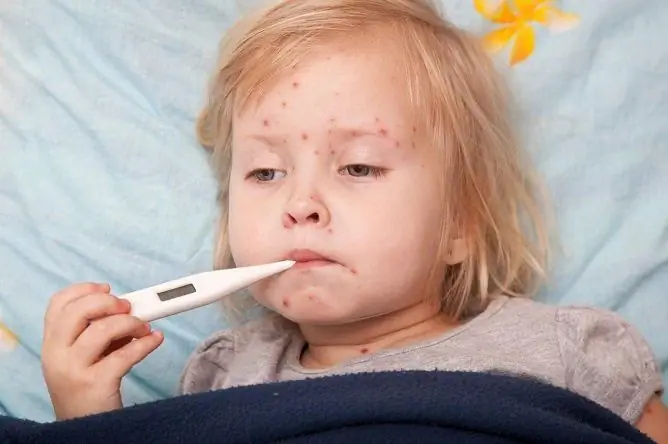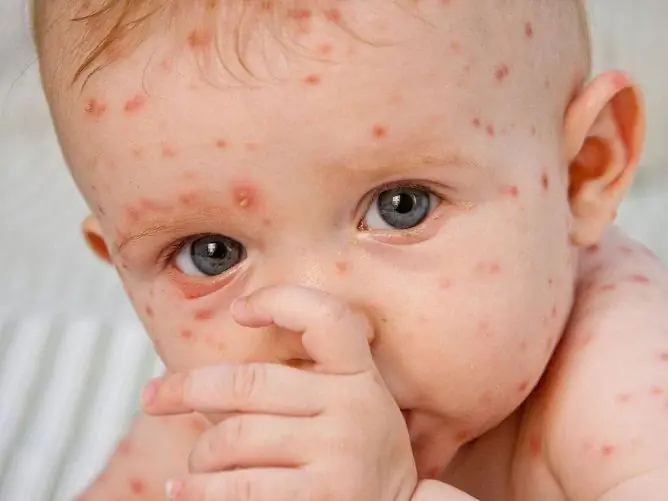- Author Rachel Wainwright [email protected].
- Public 2024-01-15 19:51.
- Last modified 2025-11-02 20:14.
Chickenpox without temperature
The content of the article:
- Clinical forms of chickenpox
- The erased form of chickenpox
- Immunity and course of chickenpox
- Vaccination and course of chickenpox
- Therapeutic tactics
- Video
Chickenpox is an acute viral infection transmitted by airborne droplets. The typical course of the disease is characterized by an increase in body temperature, moderate general intoxication, itching, and a rash on the skin and mucous membranes. But this is not the only clinical form of the disease. Possible chickenpox without fever, due to the state of immunity, the introduction of a specific immunoglobulin, vaccination. This course of the disease occurs in both children and adults.

Mild chickenpox can proceed without fever
Clinical forms of chickenpox
Chickenpox can occur in different clinical forms:
- erased, or rudimentary;
- disseminated, or generalized;
- gallbladder, or bullous;
- hemorrhagic;
- pustular;
- necrotic, or gangrenous.
Can there be chickenpox without fever? The rudimentary variant of the disease is characterized by a mild course and often a lack of temperature. All the other listed forms are atypical for the patient, but difficult.
The erased form of chickenpox
In a child, chickenpox without fever is possible at any age, but more often - from 1 year to 6-7 years or at primary school age. It is during this period that most cases of this infectious disease occur. The erased form of chickenpox usually occurs in children who received specific immunoglobulin after contact with an infection, but before the rash appears.
Immunoglobulin contains ready-made antibodies against chickenpox virus and helps the body to cope with the infection. Sometimes it is not possible to prevent the disease, but it turns out to reduce the severity of symptoms and significantly alleviate the course of the disease. Comparative characteristics of typical and erased forms are as follows.
| Clinical sign | Typical form of the disease | Erased form of the disease |
| Fever | In childhood, the temperature often rises only to subfebrile numbers, in adolescents - up to 38-38.5 ° С, in adults - up to 39 ° С. | The temperature does not rise or for a short time rises slightly to 37.1-37.3 ° С. |
| Intoxication | In infants, 1-5 days before the rash, lethargy, anxiety, decreased appetite, and often increased stool frequency appear. In older children, these signs are usually more pronounced, in adults, vomiting, severe headache, lumbar pain, and itching of the skin may additionally occur. | The general status of children is not disturbed, in adult patients there is a slight weakness, headache. |
| Skin rashes |
Typical rashes appear in parallel with the rise in temperature or a few hours later. The rash occurs in waves and undergoes changes: pink spots with a diameter of 2 to 4 mm, turn into pimples, or nodules, which, in turn, become bubbles, or vesicles. The latter are represented by single-chambered formations surrounded by a red inflammatory rim, and after 1-3 days they dry out with the formation of crusts. Finally, the skin is cleared of crusts at 2-3 weeks of the disease. |
There are few rashes. First, small pink spots appear, which quickly transform into papules. Bubbles are underdeveloped, sometimes poorly visible, formed in small quantities, do not exist for long. |
| Enanthema (rash on mucous membranes) | Rashes on the oral mucosa, rarely of the conjunctiva, genitals, appear simultaneously with a skin rash. They represent a few bubbles that open with the formation of ulcers and heal within 1-2 days. | Rashes on the mucous membranes do not occur, and if they do appear, then they exist for a short time and do not ulcerate. |
Immunity and course of chickenpox
Chickenpox without fever in adults and children is possible with a high level of general body resistance. A good state of immunity allows you to carry the infection in a mild form. In such cases, there is no fever, and the rash on the skin is extremely scarce. Often they do not even reach the stage of vesicles and crusts, but are limited to the stage of the primary morphological element - spots.
With such erased clinical manifestations, patients may not suspect that they have had chickenpox. The diagnosis can be made by laboratory serological method. Blood for immunoglobulins M and G to the varicella-zoster virus, which is the causative agent of chickenpox, can be tested at the onset of the disease and after 2-3 weeks. An increase in the titer of specific antibodies by 4 times is considered significant in terms of confirming the diagnosis. The method is applicable for retrospective diagnostics.
Vaccination and course of chickenpox
Specific prophylaxis of the disease is carried out with a live attenuated (weakened) vaccine. In some countries, the vaccine is included in the mandatory vaccination schedule. There are several vaccines: the original Japanese "Okavax" and developed on its basis "Varivax" and "Varilrix". Schemes for healthy people and high-risk contingents are presented in the table.
| Vaccine name | Vaccination rules |
| Okavax | Children under 12 months of age: 0.5 ml, which is 1 dose, subcutaneously once. |
| Varilrix | Children from 1 year to 13 years old: 0.5 ml, which corresponds to 1 dose, twice subcutaneously with an interval of 1.5-2.5 months. Adolescents over 13 years old and adults: 1 dose is administered twice with an interval between injections for 1.5-2.5 months. |
| Okavax, Varivax, Varilrix | Scheme for emergency vaccination: 1 dose corresponding to 0.5 ml, subcutaneously for the first 72 hours (optimal) or 96 hours (acceptable) after contact with a patient with chickenpox. |
Vaccination forms strong immunity for many years. But very rarely, especially if all the rules are not followed, vaccinated children and adults still get chickenpox. In this case, a mild form of the disease is noted, which is characterized by the absence of temperature, a weak manifestation of the phenomena of general intoxication, and a small number of rashes.

In children who have received the vaccine, chickenpox, if it develops, is mild
Therapeutic tactics
Therapeutic measures for chickenpox flowing without temperature are aimed at:
- elimination of the manifestations of the disease;
- prevention of secondary infection of a bacterial nature.
Patients with a mild form of the disease do not need hospitalization. Treatment should be comprehensive.
| Therapeutic direction | Recommendations |
| Mode | Bed rest in the absence of fever is optional. |
| Food | The patient's diet should be balanced and complete, with the obligatory inclusion of fermented milk and plant products. Dishes should be light and nutritious, spicy, salty, starchy and sweet should be avoided. Food should be boiled, baked or steamed. |
| Drinking regime | It is necessary, even with an erased form of infection, to drink up to 1.5-2 liters of liquid per day, preference is given to mineral water without gas, green tea, fruit juices, better freshly prepared, non-acidic juices. |
| Drug treatment | In a mild form of the disease, drug treatment is usually limited to external therapy. Treatment of the elements of the rash with disinfectants is carried out in order to prevent the addition of a secondary bacterial infection. Most often, for these purposes, a 1% alcohol solution of brilliant green or a concentrated solution of potassium permanganate (potassium permanganate) is used. Allantoin and dexapanthenol can be used to soften and heal the skin. Lotions are used to relieve itchy skin (Kalamin, etc.). |
| Aeration | It is necessary to regularly ventilate the room to provide fresh air. Disinfection due to the instability of the virus is not carried out, regular wet cleaning is sufficient. |
| Hygiene procedures | With erased chickenpox, you can and should take a bath or shower. After water procedures, the skin should not be rubbed with a towel, but gently blotted. Bed linen and underwear must be changed regularly. |
Compliance with these measures will prevent complications.
Video
We offer for viewing a video on the topic of the article.

Anna Kozlova Medical journalist About the author
Education: Rostov State Medical University, specialty "General Medicine".
Found a mistake in the text? Select it and press Ctrl + Enter.






